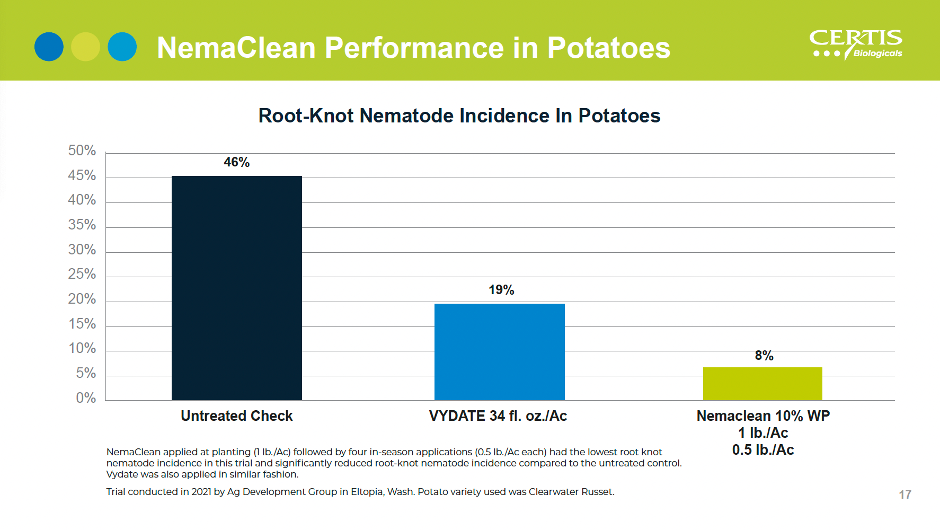By The Certis Team
Potato growers are no strangers to sneaky nematodes lurking in the soil, waiting to feed on roots. Many growers already have plant parasitic nematodes somewhere beneath the ground. But oftentimes, there’s no telling where or when they could cause damage until it’s too late to protect potato yield.
Nematode Problems for Potato Growers
Since plant parasitic nematodes live in soil and plant tissues while feeding on plant roots, potatoes are a common target.
When nematodes establish feeding sites, invade roots and eventually tubers, they reduce plant vigor and cause blemishes that result in a lower quality potato crop, both above and below the surface.
- Below the surface, nematodes can cause potatoes to become unmarketable due to lesions, increased susceptibility to Verticillium wilt, stubby roots, swellings, corky ringspot or other diseases and issues caused by root damage and reduced crop health.
- Aboveground symptoms (which could also result from other causes) can include stunted, yellowing, brown-spotted, chlorotic or dying plants, which are likely to wilt under temperature or moisture stress.
For edible potato crop producers, nematodes cause damage so unsightly that crops cannot be sold to fresh markets or go into production due to visible damage that would hinder foods like fries, chips or other items. Since potatoes have a low profit margin, growers cannot afford to lose any yield due to nematode damage.
3 Steps to Implement an IPM for Nematodes
Integrated pest management is a sustainable way for potato growers in all regions to combat nematodes. Here are three steps to implement best practices to help benefit crops.
1. Test Soil Regularly
Knowing what types of nematodes are present in the soil and their population estimates is helpful to effectively manage pests. This makes regular soil and root testing advantageous for potato growers.
If your previous season’s crop had problems caused by nematodes, consider implementing a management program for future plantings. Since nematodes often stick around in the soil and cause damage, it can be helpful to test soil samples and identify types and numbers. This can be done with a diagnostic laboratory or by participating in a nematode testing program.
- Sample the soil from the root zone of the previous crop after harvest if possible. Then, most importantly, sample again just before the new harvest.
- Divide the field into sampling blocks of about 5 acres. Take subsamples to mix and form a composite sample of 1 quart for each block.
- Be sure to keep samples cool without freezing them.
Even if you are not sure that you have nematodes or damage is not visible upon harvest, keep in mind that this can appear after potatoes are put into storage.
Regular soil testing will enable you to plan ahead, protect crop yield and effectively manage the health of your soil and potatoes.
You may be eligible for free soil testing. For more information, visit the Soil Testing Program page.
2. Follow Integrated Pest Management Best Practices
If you’re already familiar with integrated pest management (IPM) programs, you know that some of the benefits are more sustainable practices, increased resistance management and reduced residue.
In potatoes, nematode IPM can be simple as long as you are consistent and proactive in your prevention methods.
Follow these best practices:
- Start prevention of nematodes by testing and treating at planting.
- If you’re not doing a fumigation program, apply a nematicide at planting and follow up every 4-6 weeks, depending on label instructions.
- Keep your seed clean to prevent introducing nematodes upon planting.
- Keep your equipment clean and out of contaminated areas.
Learning more about the lifecycle of a nematode to understand how they feed, grow and multiply is helpful to more effectively control the pest and prevent crop damage.
3. Choose Sustainable Crop Solutions
As the industry continues to move towards more sustainable growing practices, bionematicides can be a highly effective nematode management method to help protect resources.
Going the sustainable route doesn’t mean you have to sacrifice performance.
Bionematicides contain active ingredients derived from natural sources or microorganisms, which can be alive or inactivated based on biochemicals produced by such organisms. NemaClean® is a non-fumigant product that is naturally derived from a beneficial fungus, Purpureocillium lilacinum strain PL11, that specifically targets plant-parasitic nematodes without harming beneficial nematodes.
A recent field trial in Washington proved that NemaClean® 10% WP significantly reduced nematode damage to tubers in comparison to untreated potatoes and those treated by Vydate, another chemical used to prevent nematode incidence. With good efficacy even at lower rates, NemaClean® is more cost-effective across the season than other biological nematicides.

While it is natural, NemaClean® is a non-fumigant product with superior application flexibility that can help enhance an existing IPM strategy. With a high-performing sustainable nematicide like this, it’s much easier to tackle the root of the problem and protect a potato crop from yield-robbing nematodes.
Learn more about NemaClean®.




